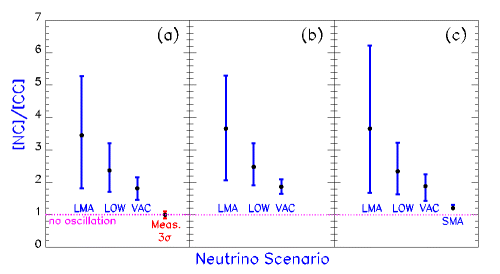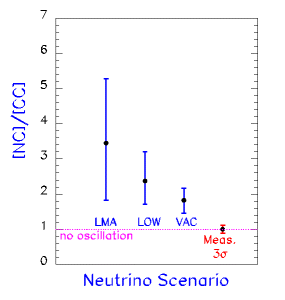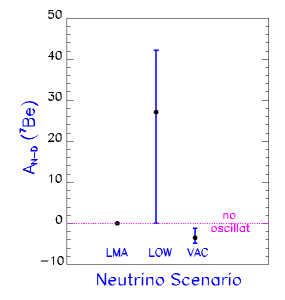 |
Global neutrino oscillation solutions for three different analysis strategies.
Postscript file Pdf file |
 |
Standard global oscillation solution (one panel).
Postscript file Pdf file |
 |
The neutral current to charged current double ratio, [NC]/[CC] (three
panels, 3 sigma range).
Postscript file Ppf file |
 |
The neutral current to charged current double ratio, [NC]/[CC] (one
panel, 3 sigma range).
Postscript file Ppf file |
 |
The percentage difference between the night and the day CC
rates (three panels, 3 sigma range).
Postscript file Ppf file |
 |
The percentage difference between the night and the day CC
rates (one panel, 3 sigma range).
Postscript file Ppf file |
 |
The left panel shows the currently allowed regions for the neutrino
oscillation parameters that predict a neutral current to charged
current double ratio, and the right panel shows the currently allowed
region that predicts a CC night-day difference.
Postscript file Ppf file |
 |
The correlation between the neutral current to charged current double
ratio, and the charged current day-night effect.
Postscript file Ppf file |
 |
The 7Be neutrino event rate (three panels, 3 sigma range).
Postscript file Ppf file |
 |
The 7Be neutrino event rate (one panel, three sigma range).
Postscript file Ppf file |
 |
The percentage difference between the night and the day rates for
recoil electrons with kinetic energies in the range 0.25 MeV <
Te < 0.8 MeV (one panel, 3 sigma range).
Postscript file Ppf file |
 Back to John Bahcall's Neutrino Viewgraphs
Back to John Bahcall's Neutrino Viewgraphs
Address questions and comments about this server to webmaster@sns.ias.edu